The Cazuela That the Farm Maiden Stirred

The Cazuela That the Farm Maiden Stirred
by Samantha R. Vamos,
illustrated by Rafael Lopez
Ages 4-8
Published by Charlesbridge (Feb 2011)
Sometimes, there is an inexplicable cosmic coincidence that brings things together in our lives, be it as profound as meeting our spouses, or as simple as finding a beautifully illustrated children's book.
I was at the post office a while back and noticed the new set of stamps released recently. Now, going to the P.O. has become a rarity in today's life. And, while there, browsing and finding stamps I want to buy is a luxury. I used to collect stamps and appropriated my dad's ancient collection when I was young, but, between college and moving across continents, all that is lost. I must admit I have a weakness for stamps still, and manage to get most of the commemorative ones for
So, it does seem like a mysterious concatenation of circumstances that made me notice the Latin Music Legends set of stamps. While all the names of the legends there were familiar, I was struck by the fact that we had just read about Celia Cruz - book + CD from the library, called Celia Cruz, Queen of Salsa by Veronica Chambers.
But, most of all, Rafael Lopez, the designer of the stamps entered our little world and made it beautiful and bright.
And, that is how we came upon The Cazuela that the Farm Maiden Stirred, and got introduced to Samantha Vamos.
The bilingual book presents a cumulative story, much like This is the House that Jack Built, where we not only follow the progressive unfolding of events, but also learn a bit of Spanish. Each page introduces a new item in English, but on successive pages that item is referred to by the Spanish word, and it gets quite challenging (and fun) to keep up.
We start with the innocuous,
This is the pot that the farm maiden stirred.
Next, we read,
This is the butter that went into the cazuela that the farm maiden stirred..
Then,
This is the goat that churned the cream to make the mantequilla that went into the cazuela that the farm maiden stirred.
There is an underlying reason for everything that happens in this lively sequence: the making of Arroz con Leche, Rice Pudding.
The text flows easily, blending the two languages. The author shares, "As I incorporated Spanish words, the text flowed differently – the words sounded more intimate and tender. The English text with Spanish words woven in resonated because the bilingual manner of speaking reminded me of the way I had heard languages (in addition to English, my father fluently speaks four languages) expressed as a child."
Growing up with 3 different languages, besides English, and studying in English-medium school, I could identify with the author's note about having "bilingual on the brain" as shared in this article. To this day, I constantly "mix" Tamil, Hindi, Malayalam words into my thoughts and internal conversations as I primarily think in English.
The illustrations are breath-taking, vibrant and rather funny. From stark white background on the first 2 or 3 pages as we focus on the cazuela, mantaquilla and cabra, the images get rusty orange and colorful as the day progresses. The cabra with his toque, the gallina with her apron, the burro with his boots all add to the charm.
As artist Rafael Lopez shares in the post Stirring the Pot of Color, "For me color is an expression of my identity, my heritage and I believe it is the most direct route to the emotions of children and families who will turn the pages of my books". It is his bold colors, arresting images and textures that catch the eye, holding us ransom.
Little touches like the smiling sol looking in through the doorway, the gallina laying the eggs while grating the limon as the campesino tends to her... well, just about every single page is incredibly gorgeous, and complements the text well.
Back of the book has Arroz con Leche recipe and Glossary of Spanish Words.
[image source: author Samantha Vamos website]
Labels: ages 4-8, bilingual, books, multiculural, picture book, picture-book-challenge


















 Back in 2007,
Back in 2007, 


